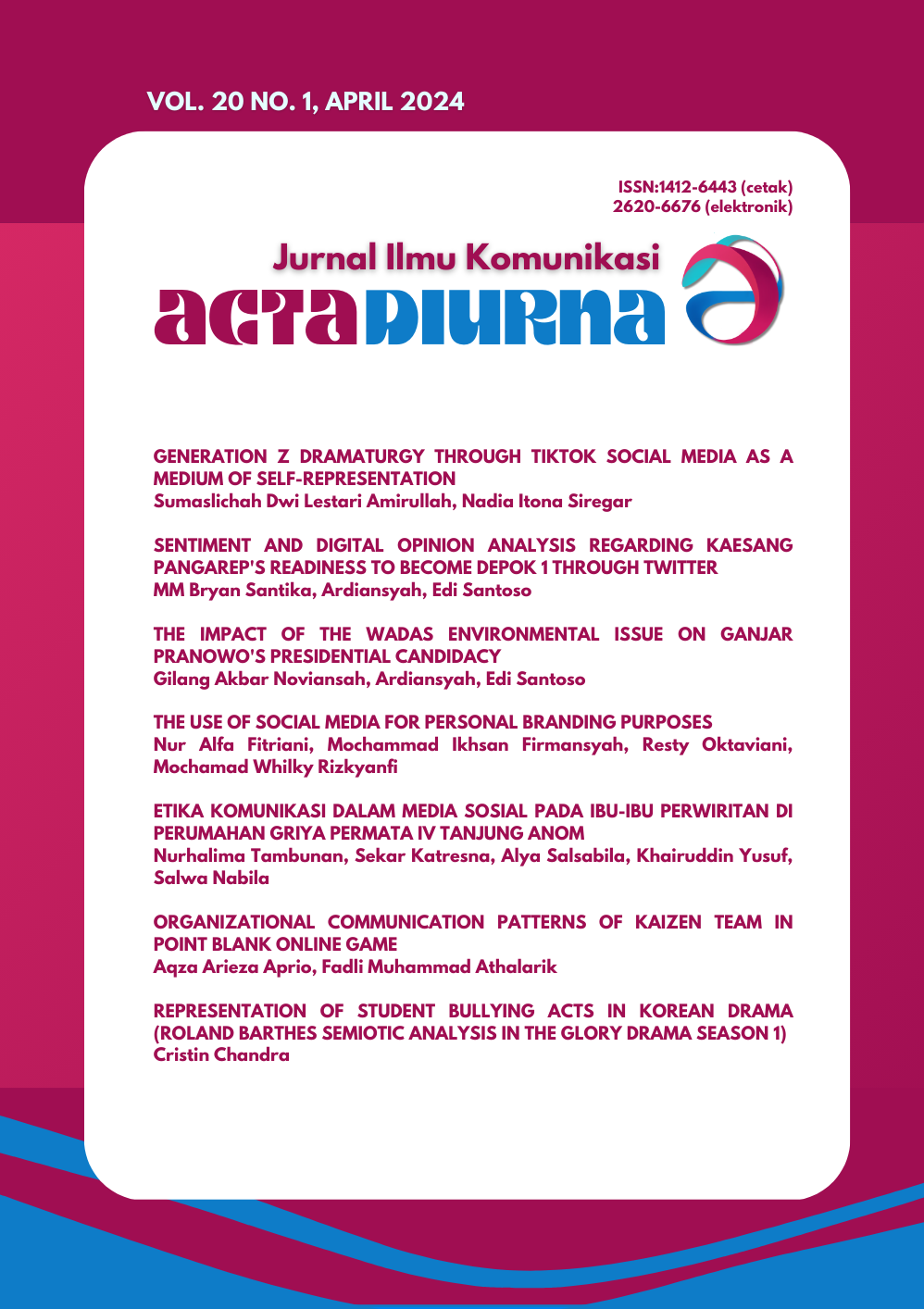THE PUNK COMMUNITY'S RECEPTION OF SELF-CONCEPT PORTRAYALS IN THE MEDIA
Abstract
The problem is punk kids are always considered negative and underestimated by society. This study aims to find out how punk children perceive their self-concept in media. The method used is a qualitative method with a descriptive type. The data sources obtained by researchers used data collection, such as interviews with punk child informants, observation and documentation. The results of the study found that there were several factors for punk children, namely from family factors and friendship factors. This punk kid always gets negative comments about him. However, all the punk kids did was stay silent and didn't care about what was being commented on. This punk kid perceives his self-concept image in online media with its pros and cons. Punk kids see their self-concept as negative because there are people who wear punk-worthy attributes or appearances, but these people don't know what punk really means and often commit crimes. Therefore, punk is always labeled negatively even though it is not punk who does it. And also punk kids who think positively because one of the punk kids has seen his self-concept in a movie and in that movie he has high solidarity with social concerns.
References
Althusser, Louis. (1984). Essay on Ideology. London: Verso
Ardiansyah, B. K., & Ardiansyah, F. H. (2020). Efektivitas Peraturan Daerah Kota Payakumbuh Nomor 5 Tahun 2007 Dalam Penertiban Anak Punk. Jurnal Tatapamong, 2(September), 17–30. https://doi.org/10.33701/jurnaltatapamong.v2i2.1217
Carol A Wade. 2002. Psikologi. Jakarta: Erlangga
Chicilia Christi. 2005 Pengalaman Komunikasi dan Konsep Diri Anggota Komunitas Punk di Kota Pekanbaru dalam Perspektif Fenomenologi. Pekanbaru. Universitas Riau
Chotim, E. R., & Latifah, S. U. (2018). Komunitas Anak Punk dan Anomali Sosial (Studi Kasus di Kecamatan Ujung Berung Kota Bandung) Endah. Jurnal JISPO, 8(1), 69–93
Creswell, John W. 2012. Research Design Pendekatan Kualitatif, Kuantitatif, dan Mixed. Yogyakarta: Pustaka Pelajar.
Darmadi, Hamid. (2013). Metode Penelitian Pendidikan dan Sosial. Bandung: Alfabeta.
Farid Firmansyah. (2019). Manajemen Kualitas Jasa. Duta Media Publishing.
Handayani, Kartika. (2009). “Identifikasi Anak Jalanan di Kota Medan”.
Harahap, H. S., Hubeis, A. V. S., Saleh, A., & Matindas, K. (2021). Bentuk Media Komunikasi Perempuan Lurah dalam Mensosialisasikan Penertiban Bangunan Liar untuk Menciptakan Keamanan Lingkungan Kota Bekasi (Form of Communication Media of Women Headman in Socializing The Wildlife Building to Create The Security Of The Cit. Jurnal Keamanan Nasional, VII(2), 254–271.
Herdiansyah, Haris. (2010). Metode Penelitian Kualitatif untuk Ilmu-ilmu Sosial. Jakarta: Salemba Humanika.
John Martono, Arsita Pinandita.(2009). PUNK Fesyen-Subkultur-Identitas. Yogyakarta: Halilintar Books.
Kriyantono, Rachmat. (2014). Teknik Praktis Riset Komunikasi. Jakarta: Kencana
Marshall,G. (2005). Skinhead Nation Truth About The Skinhead Cult. London: Dunnon
Moleong, Lexy J. (2010). Metodologi penelitian kualitatif. Bandung: Remaja Rosdakarya
Mulyana, Deddy. (2003). Metodologi Penelitian Kualitatif. Bandung: Remaja Rosdakarya
Mulyana, Deddy. (2005). Ilmu Komunikasi Suatu Pengantar. Bandung: PT. Remaja Rosdakarya.
Mulyana, Deddy. (2008). Ilmu Komunikasi: Suatu Pengantar. Bandung: Remaja Rosdakarya
Nazir, Moh. (2014). Metode Penelitian. Bogor: Ghalia Indonesia.
Rakhmat, Jalaludin. 2009. Metode Penelitian Komunikasi. Bandung : PT Remaja Rosdakarya.
Rianse, Usman. (2008). Metodologi Penelitian Sosial dan Ekonomi:Teori dan Aplikasi.Bandung: Alfabeta
Setiadi, M Elly. (2009). Ilmu Sosial dan Budaya Dasar, Jakarta: Kencana.
Siregar, Hairani. (2004). “Faktor Dominan Anak Menjadi Anak Jalanan di Kota Medan”.
Suharsimi, Arikunto. (2013). Prosedur Penelitian Suatu Pendekatan Praktek. Jakarta: Rineka.
Sunarto. 2011. Pengantar Sosiologi. Jakarta: Lembaga Penerbit Fakultas Ekonomi Universitas Indonesia
Suprobo, T., Siahainenia, R., & Sari, D. K. (2016). Analisis Framing Media Online Dalam Pemberitaan Profil dan Kebijakan Menteri Susi Pudjiastuti (Studi Pada Situs Berita Detik.com, Kompas.com dan Antaranews.com periode Oktober - Desember 2014). Cakrawala Jurnal Penelitian Sosial, 5(1), 119–138. http://ejournal.uksw.edu/cakrawala/article/view/499
Toni, A., & Fajariko, D. (2018). Studi Resepsi Mahasiswa Broadcasting Universitas Mercu Buana Pada Film Journalism “Kill The Messenger”. Komunikasi, 9(2), 151. doi:10.24912/jk.v9i2.161
Usman, Husaini. (2009). Metodologi Penelitian Sosial. Jakarta: Bumi Aksara.
Internet :
Ratnawaty, E., Umi Siti (2018). KOMUNITAS ANAK PUNK DAN ANOMALI SOSIAL (Studi Kasus di Kecamatan Ujung Berung Kota Bandung). https://media.neliti.com/media/publications/431552-none-0fdab51d.pdf
Wahyu, Dhita (2016). PERSEPSI MASYARAKAT TERHADAP KEHIDUPAN ANAK PUNK DITINJAU DARI ASPEK SOSIAL DAN BUDAYA DI YOGYAKARTA (STUDI KASUS DI KOMUNITAS ANAK PUNK YOGYAKARTA). http://repository.upy.ac.id/1777/1/Artikel.pdf
Stuart Hall and the Rise of Cultural Studies | The New Yorker

This work is licensed under a Creative Commons Attribution-ShareAlike 4.0 International License.
Authors who publish with this journal agree to the following terms:
- Authors retain copyright and grant the journal right of first publication with the work simultaneously licensed under a Creative Commons Attribution License that allows others to share the work with an acknowledgment of the work's authorship and initial publication in this journal.
- Authors are able to enter into separate, additional contractual arrangements for the non-exclusive distribution of the journal's published version of the work (e.g., post it to an institutional repository or publish it in a book), with an acknowledgment of its initial publication in this journal.
- Authors are permitted and encouraged to post their work online (e.g., in institutional repositories or on their website) prior to and during the submission process, as it can lead to productive exchanges, as well as earlier and greater citation of published work (See The Effect of Open Access).














